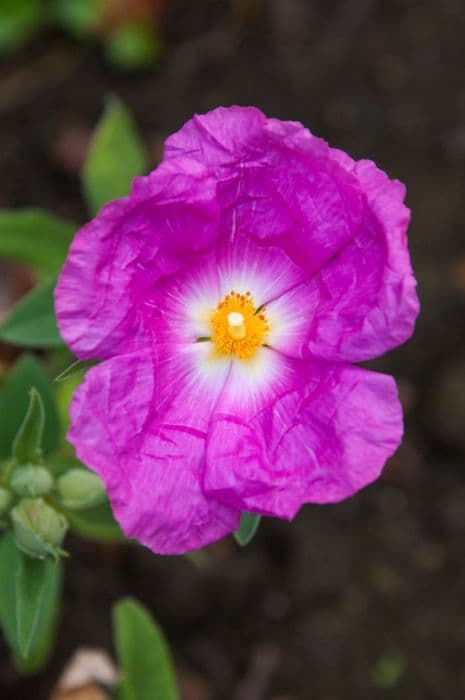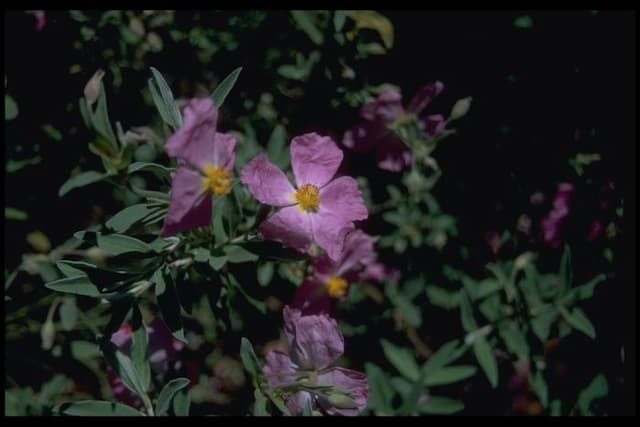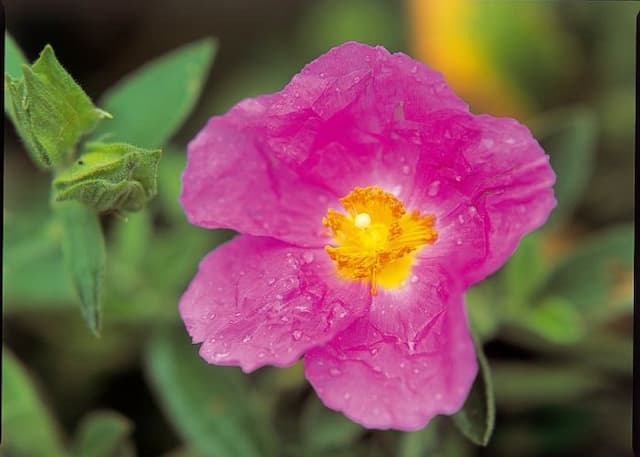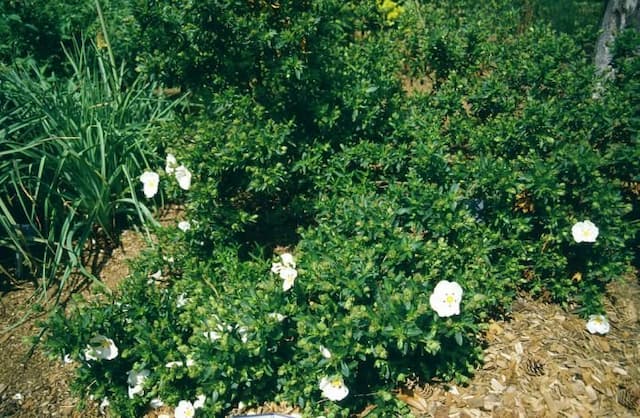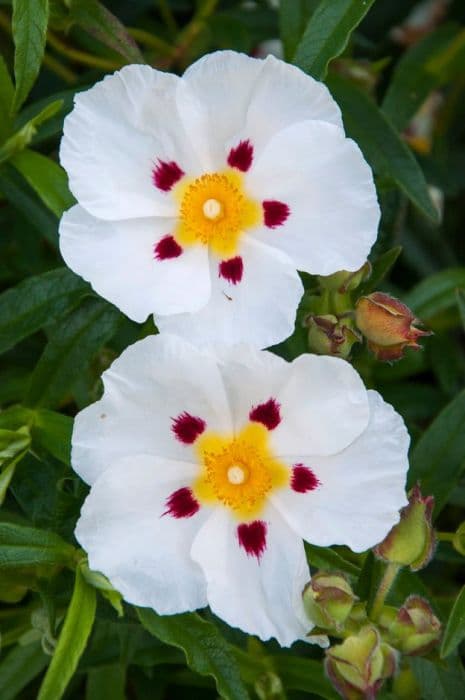Rock Rose Cistus × dansereaui 'Decumbens'
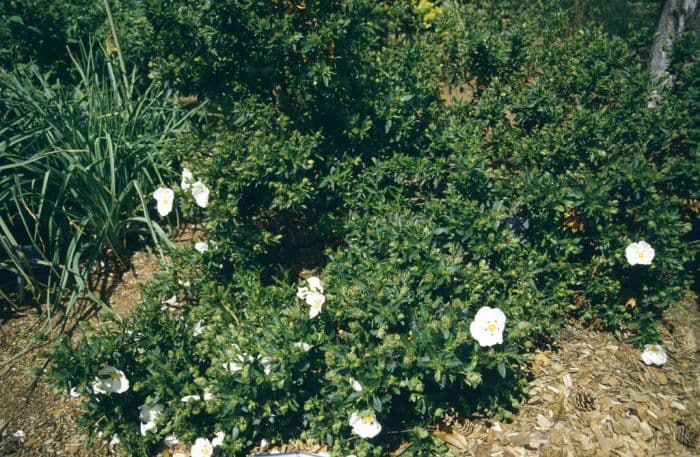
ABOUT
The plant you're asking about, commonly known as Rock Rose, displays a beautiful and rich appearance. It showcases a dense spread of evergreen foliage that remains throughout the year, providing a constant backdrop of lush greenery. The leaves are small and have a slightly sticky texture, with a dark green color on top and a paler underside, giving a delightful two-toned effect to the shrub. During its blooming season, the Rock Rose is adorned with a profusion of flowers. Each bloom has a delicate and crinkled appearance, resembling tissue paper. The flowers are a striking white color, with each petal marked distinctly at the base by a blotch of yellow. A characteristic feature of these blooms is the prominent red or maroon spot at the base of each petal, adding a touch of drama against the white background. Despite their dainty look, the flowers are fairly resilient and stand out beautifully against the foliage. While this species is known for its sprawling habit, often appearing to cascade or spill gently, the specific appearance, including how pronounced this cascading effect is, can vary depending on the individual plant and its growing conditions. The plant can give a superb ground-covering effect, spreading itself out and intermingling with its surroundings, which can add to the garden's overall aesthetics.
About this plant
 Names
NamesFamily
Cistaceae
Synonyms
Rock Rose, Cistus 'Decumbens'
Common names
Cistus × dansereaui 'Decumbens'.
 Toxicity
ToxicityTo humans
The Cistus, also known as Rockrose, is not commonly known to be toxic to humans. However, as with any plant, some individuals may experience irritation or allergic reactions when handling or ingesting Cistus. In the event that any part of the plant is ingested and an adverse reaction occurs, medical attention should be sought. General symptoms of plant poisoning can include nausea, vomiting, diarrhea, abdominal pain, and skin irritation.
To pets
The Cistus, or Rockrose, is not commonly known to be toxic to pets. However, individual animals can sometimes react differently to plants, and there might be cases of pets displaying sensitivity or allergic reactions to this plant. If you suspect your pet has ingested Rockrose and is showing signs of distress such as vomiting, diarrhea, drooling, or changes in behavior, it is recommended to contact a veterinarian.
 Characteristics
CharacteristicsLife cycle
Perennials
Foliage type
Evergreen
Color of leaves
Green
Flower color
White
Height
1 foot (0.3 meters)
Spread
5 feet (1.5 meters)
Plant type
Shrub
Hardiness zones
8
Native area
Mediterranean
Benefits
 General Benefits
General Benefits- Low Maintenance: Cistus 'Decumbens' typically requires minimal upkeep once established, making it ideal for gardeners who prefer plants that don't need constant attention.
- Drought Tolerant: This plant is able to withstand periods of dryness once established, which can be particularly beneficial in regions with water scarcity or hosepipe bans.
- Attracts Pollinators: The flowers of the plant provide a nectar source for bees and other beneficial insects, supporting biodiversity in the garden.
- Ground Cover: Its low-growing, spreading habit makes it an excellent ground cover choice, helping to suppress weeds and reduce soil erosion.
- Ornamental Value: With its attractive flowers and evergreen foliage, Cistus 'Decumbens' adds year-round visual appeal to gardens and landscapes.
- Deer Resistant: The plant is generally not favored by deer, making it suitable for gardens in areas where deer browsing can be a problem.
- Fire-resistant Planting: Cistus 'Decumbens' is considered fire-retardant, which can be beneficial for fire-prone areas when creating defensible space around properties.
- Coastal Conditions Adaptability: It can tolerate saline soils and wind, making it suitable for coastal gardens where other plants might struggle.
 Medical Properties
Medical PropertiesThis plant is not used for medical purposes.
 Air-purifying Qualities
Air-purifying QualitiesThis plant is not specifically known for air purifying qualities.
 Other Uses
Other Uses- Cistus × dansereaui 'Decumbens', commonly known as the rock rose, can be used in creating natural dyes for fabrics, especially imparting a delicate yellow to beige color depending on the mordant used.
- Its sticky leaves may serve as a natural trap for small insects, providing an ecological pest control in home gardens.
- The plant material, when dried, can be included in potpourri mixes not only for its potential fragrance but also for its aesthetic appeal.
- The densely growing shrubs can be used as a low-maintenance, informal hedge in dry and sunny garden landscapes.
- Rock rose can act as a valuable source of nectar and pollen for bees and other pollinators when other food sources are scarce.
- The plant can be incorporated into erosion control programs, especially in arid and semi-arid regions, due to its drought resistance.
- The fibrous stems, when dried, can be experimented with in traditional basketry or weaving as a source of plant fiber.
- Rock rose is sometimes used for bonsai, as some enthusiastic gardeners appreciate its gnarly stems and the challenge it presents due to its rapid growth.
- The leaves can be used to add an interesting texture and visual contrast in fresh floral arrangements or as a filler in bouquets.
- In wildlife gardens, rock rose can provide shelter for small animals and insects, encouraging biodiversity and a balanced ecosystem.
Interesting Facts
 Feng Shui
Feng ShuiThe Rockrose is not used in Feng Shui practice.
 Zodiac Sign Compitability
Zodiac Sign CompitabilityThe Rockrose is not used in astrology practice.
 Plant Symbolism
Plant Symbolism- Resilience - Cistus, commonly known as Rock Rose, often thrives in poor soil conditions and withstands drought, symbolizing the ability to endure and overcome difficulties.
- Beauty - The Rock Rose's delicate flowers represent beauty, reminding us of nature's aesthetics and the fleeting nature of physical attractiveness, as the blossoms tend to last only a day.
- Healing - Historically, the Rock Rose has been used in folk medicine, and as such, it symbolizes healing and the soothing of wounds, both physical and emotional.
- Protection - The sticky resin produced by the Rock Rose was once believed to repel snakes and evil, hence it symbolizes protection against negativity and harm.
- Purity - With its bright, often white flowers, the Rock Rose symbolizes purity and innocence, representing clarity of thought and intent.
 Water
WaterRockrose prefers to be watered deeply but infrequently to encourage a strong root system. It's best to check the top 2 inches of soil and water only when this layer feels dry to the touch. Generally, watering once every week or two is sufficient, but this may vary depending on climate and soil conditions. Aim to provide the rockrose with about 1 to 2 gallons of water per watering session during the active growing season. Decrease the frequency of watering during the winter months when the plant is dormant.
 Light
LightRockrose thrives in full sunlight conditions and will perform best when it receives at least six hours of direct sunlight each day. The best spot for rockrose is an area where it can enjoy uninterrupted sun exposure throughout the day, away from any shade-casting structures or trees.
 Temperature
TemperatureRockrose is a hardy plant that can tolerate a range of temperatures and is well-adapted to hot climates. It generally prefers temperatures between 40°F and 90°F and can survive minimum temperatures down to 15°F. However, the ideal growing conditions fall within the warmer end of this spectrum.
 Pruning
PruningPruning rockrose helps to maintain its shape and encourage bushier growth. The best time to prune is in late winter or early spring before new growth begins. Pruning can be done annually, removing about one-third of the older branches to stimulate fresh growth and flowering.
 Cleaning
CleaningAs needed
 Soil
SoilRockrose prefers well-draining soil with added grit or sand to improve drainage; a mix of two parts loam, one part peat, and one part sharp sand is recommended. Aim for a soil pH range of 5.5 to 7.5.
 Repotting
RepottingRockroses do not require frequent repotting and can be repotted every 2-3 years or when outgrowing their current pot, preferably in spring or early summer.
 Humidity & Misting
Humidity & MistingRockrose thrives in low to moderate humidity levels typical of Mediterranean climates and does not need high humidity to grow well.
 Suitable locations
Suitable locationsIndoor
Place in bright light, limit watering, avoid high humidity.
Outdoor
Full sun, sheltered spot, well-drained soil, infrequent water.
Hardiness zone
8-11 USDA
 Life cycle
Life cycleCistus × dansereaui 'Decumbens', commonly known as Rockrose 'Decumbens', begins its life cycle as a seed, requiring well-draining soil and exposure to sunlight to germinate. Upon sprouting, the seedling emerges and establishes itself, developing a root system and foliage. As it enters the vegetative stage, the plant grows and spreads out, forming a low, mounding shrub with evergreen leaves. The flowering stage occurs in late spring to early summer, displaying its characteristic yellow-centered, white-petaled flowers that attract various pollinators. After pollination, the flowers develop into capsules containing seeds, which are dispersed by wind or wildlife, thus enabling the cycle to begin anew. The plant is also capable of asexual reproduction through cuttings, allowing gardeners to propagate new plants identical to the parent.
 Propogation
PropogationPropogation time
Spring-Early Summer
Cistus × dansereaui 'Decumbens', commonly known as Rockrose, is best propagated by semi-ripe cuttings in late summer. To do so, a gardener should select a healthy stem that has started to harden but is not fully woody. Cut a section about 4 to 6 inches (10 to 15 centimeters) long, making the cut just below a leaf node, and remove the leaves from the lower half of the cutting. Dipping the cut end in rooting hormone can help encourage root growth. The cutting should then be placed in well-draining potting mix, ensuring that it stands upright and the leafless section is buried. The container with the cutting should be kept moist and in a warm place with indirect light until roots develop, which can take several weeks. Once rooted, the new Rockrose plants can be transplanted to their final location.
